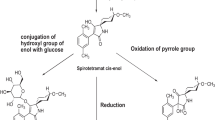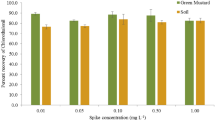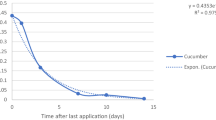Abstract
Dissipation and persistence of fenazaquin residues in chilli and soil were studied for 2 years following two applications of fenazaquin at 10-day interval. The limit of detection and limit of quantification were 0.003 and 0.01 mg kg−1. The mean initial deposits of fenazaquin 10 EC on green chilli fruits were found to be 0.74, 1.17, and 1.79 mg kg−1 after the application @ 125 (X dose), 156.25 (1.25X dose), and 250 (2X dose) g a.i. ha−1, respectively, during the first year followed by 0.78, 1.20, and 1.70 mg kg−1, respectively, during the next year. The mean initial deposits in soil were found to be 0.18, 0.25, and 0.44 mg kg−1 for the X, 1.25X, and 2X doses, respectively, during the first year and 0.19, 0.22, and 0.39 mg kg−1, respectively, during second year. The residues of fenazaquin in green chilli dissipated above 96% at 20 days in the three different doses whereas in red chilli, the residues were present on 25 days and at maturity, residues were below the limit of quantification (LOQ). In soil, the residues dissipated below the LOQ at 15 days for X and 1.25X while 20 days for the 2X dose, respectively. The half-life values in green chilli fruits and soil for the fenazaquin were found to be in the range of 3.22–3.93 days and 2.41–3.35 days, respectively. The waiting period was calculated to be 3, 5, and 8 days for green chilli after the application of fenazaquin at 25, 156.25, and 250 g a.i. ha−1, respectively.






Similar content being viewed by others
Data availability
No datasets are being shared with the manuscript.
References
Anonymous (2021a) Agriculture statistics at a glance 2021. Directorate of Economics and Statistics, Government of India
Anonymous(2021b) Package of practices for cultivation of vegetables.pp 200.
Anusha SB, Ghante VN, Harischandra Naik R (2019) Dissipation study and persistence of diafenthiuron in green chilli fruits. J Ent Zool Stud 7(1):435–440
Balasubramani KJ, Vijayan L, Sunitha CS (2019) Pesticide residue contamination study in chilli in Karnataka by LC-MS/MS and GC-MS/MS analyses. Int Adv Res J Sci Eng Technol 6(11):48–56
Bhattacharyya J, Kumar Pramanik S, Banerjee H, Bhattacharyya A (2010) Effect of pH on the fate of fenazaquin in soil and water under laboratory-simulated condition. Toxicol Environ Chem 92(6):1083–1092. https://doi.org/10.1080/02772240903360521
Chirumella M, Kenganal M, Maresh SY, Ashwathnarayana SD, Hosmani A (2021) Management of chilli leaf curl disease by vector control using new and novel insecticides. Int J Curr Microbiol Appl Sci 10(2):3085–3093. https://doi.org/10.20546/ijcmas.2021.1002.337
Duhan A, Kumar B (2011) Degradation studies of fenazaquin in soil under field and laboratory conditions. Bull Environ Contam Toxicol 87:180–183. https://doi.org/10.1007/s00128-011-0318-8
Duhan A, Kumari B, Gulati R (2010) Effect of household processing on fenazaquin residues in okra fruits. Bull Environ Contam Toxicol 84:217–220. https://doi.org/10.1007/s00128-009-9863-9
Edwards CA (1975) Factors that affect the persistence of pesticides in plants and soils. Pure App Chem 42(42767):39–56. https://doi.org/10.1351/pac19754201003
Fantke P, Juraske R (2013) Variability of pesticide dissipation half-lives in plants. Environ Sci Technol 47(8):3548–3562. https://doi.org/10.1021/es303525x
Gennari M, Zannini E, Cignetti A, Bicchi C, D’Amato A, Taccheo M, Spessotto C, De Paoli M, Flori P (1985) Vinclozolin decay on different grape vines in four different Italian areas. J Agric Food Chem 33:1232–1237
Goci E, Haloci E, Di Stefano A, Chiavaroli A, Angelini P, Miha A, Cacciatore I, Marinelli L (2021) Evaluation of in vitro capsaicin release and antimicrobial properties of topical pharmaceutical formulation. Biomolecules 11(3):432. https://doi.org/10.3390/biom11030432
Hoskins WM (1961) Mathematical treatment of loss of pesticide residues. FAO Plant Prot Bull 9:163–168
Jyot G, Mandal K, Battu RS, Singh B (2013) Estimation of chlorpyriphos and cypermethrin residues in chilli (Capsicum annuum L.) by gas–liquid chromatography. Environ Monit Assess 185(7):5703–5714. https://doi.org/10.1007/s10661-012-2977-2
Kaur S, Kang BK, Sharma S, Kumar Sahoo S (2020) Dissipation kinetics of fenazaquin residues in okra and soil under subtropical conditions of Punjab, India. Int J Environ Anal Chem 102(6):1452–1466. https://doi.org/10.1080/03067319.2020.1738416
Khay S, Choi J, Abd El-Aty M (2008) Dissipation behavior of lufenuron, benzoyphenylurea insecticide, in/on Chinese cabbage applied by foliar spraying under greenhouse condition. Bull Environ Contam Toxicol 81:369–372
Kumar V, Tewary DK, Ravindranath SD, Shanker A (2006) Investigation in tea on fate of fenazaquin residue and its transfer in brew. Food Chem Toxicol 44(4):596–600. https://doi.org/10.1016/j.fct.2005.10.010
Nasr IN, Montasser MR, Macklad MF (2009) Residue analysis of difenoconazole, emamectin benzoate and fenazaquin on tomatoes using high pressure liquid chromatography. Alex Sci Exch J 30:22. https://doi.org/10.21608/asejaiqjsae.2009.2354
Patil VM, Singh S, Thorat SS, Patel KG, Patel ZP (2019) Persistence of different insecticides in chilli fruits. Int J Chem Stud 7(3):2132–2135
Sangeetha S, Ramaraju K (2013) Relative toxicity of fenazaquin against two-spotted spider mite on okra. Int J Veg Sci 19(3):282–293. https://doi.org/10.1080/19315260.2012.725320
Sangle PM, Korat DM (2018) Impact of pesticidal sprays in reducing sucking pests population on chilli. Int J Curr Microbiol Appl Sci 6:478–486
SANTE (2021) Analytical quality control and method validation procedures for pesticide residues analysis in food and feed Document N° SANTE/11312/2021. (Document N° SANTE/12682/2019)
Singh S, Dubey JK, Katna S, Sharma A, Devi N, Brar GS, Singh G, Gautam H, Thakur N (2022) Dissipation pattern and dietary risk assessment of some commonly used insecticides on tomato (Solanum lycopersicum L.). Biomed Chromatogr 19:e5372. https://doi.org/10.1002/bmc.5372
SinghY MK, Singh B (2015) Persistence and risk assessment of cypermethrin residues on chilli (Capsicum annuum L.). Environ Monit Assess 187(3):1–10. https://doi.org/10.1007/s10661-015-4341-9
Sushil CR, Kumari B, Jaglan RS (2018) Studies on persistence and dissipation behavior of selected pesticides in hot pepper (Capsicum annuum). Int J Chem Stud 6(1):1791–1794
Turan NB, Maltepe E, Chormey DS, Bakırdere S (2020) Determination of fenazaquin in water and tomato matrices by GC-MS after a combined QuEChERS and switchable solvent liquid phase microextraction. Environ Monit Assess 192(2):72. https://doi.org/10.1007/s10661-019-8061-4
Varghese TS, Mathew TB, George T, Beevi SN, Xavier G (2011) Dissipation of propargite and spiromesifen in/on chilli fruits. Pestic Res J 23(2):135–139
Xavier G, Chandran M, George T, Beevi SN, Mathew TB, Paul A, Arimboor R, Vijayasree V, Pradeep Kumar GT, Rajith R (2014) Persistence and effect of processing on reduction of fipronil and its metabolites in chilli pepper (Capsicum annum L.) fruits. Environ Monit Assess 186(9):5429–5437. https://doi.org/10.1007/s10661-014-3792-8
Yaqoob M, Zaki FA, Mukhtar M, Ahmed SB, Khan MA, Ayoub L, Bin-Farook U, Anjum SI, Ansari MJ, Almoallim HS, Alharbi SA (2021) Residual fate of fenazaquin (10EC) in apple fruit and soil. J King Saud Univ Sci 33(4):101415. https://doi.org/10.1016/j.jksus.2021.101415
Acknowledgements
The authors are thankful to the professor and head, Department of Entomology, Punjab Agricultural University, Ludhiana, and DST-FIST (Project No SR/FST/LSI/636/2015(c)) for providing the necessary facilities.
Author information
Authors and Affiliations
Contributions
Himani Aggarwal: standardization of methodology, crop growing, sample analysis, and writing the manuscript. Kousik Mandal: study plan, supervision, writing, reviewing, editing, and resource generation. B. K. Kang: supervision, writing, reviewing, editing, and resource generation.
Corresponding author
Ethics declarations
Ethics approval and consent to participate
Not applicable.
Consent for publication
Not applicable.
Competing interests
The authors declare no competing interests.
Additional information
Responsible Editor: Ester Heath
Publisher’s note
Springer Nature remains neutral with regard to jurisdictional claims in published maps and institutional affiliations.
Rights and permissions
Springer Nature or its licensor (e.g. a society or other partner) holds exclusive rights to this article under a publishing agreement with the author(s) or other rightsholder(s); author self-archiving of the accepted manuscript version of this article is solely governed by the terms of such publishing agreement and applicable law.
About this article
Cite this article
Aggarwal, ., Mandal, K. & Kang, B.K. Dissipation kinetic study of fenazaquin in chilli and soil by LC-MS/MS. Environ Sci Pollut Res 30, 91902–91914 (2023). https://doi.org/10.1007/s11356-023-28696-2
Received:
Accepted:
Published:
Issue Date:
DOI: https://doi.org/10.1007/s11356-023-28696-2




